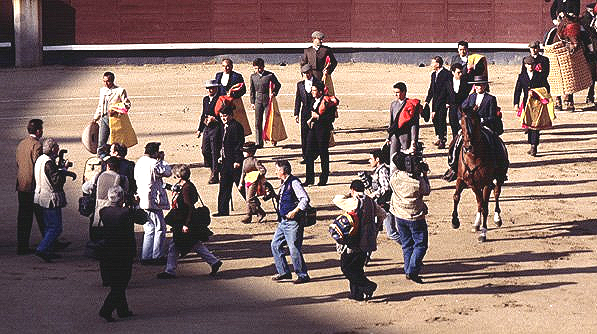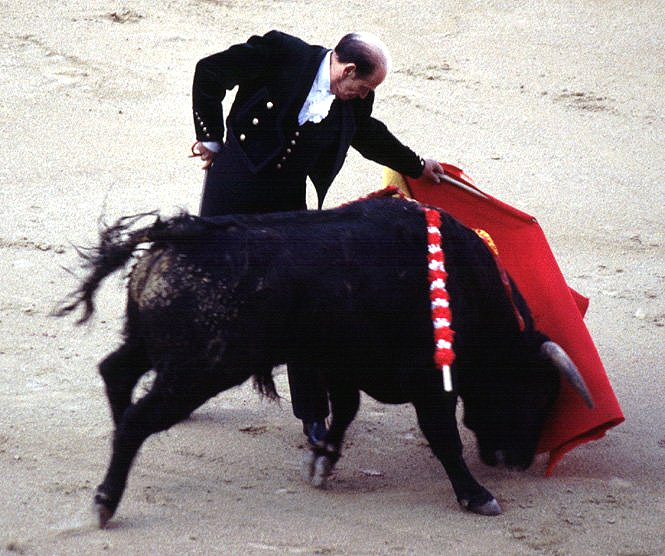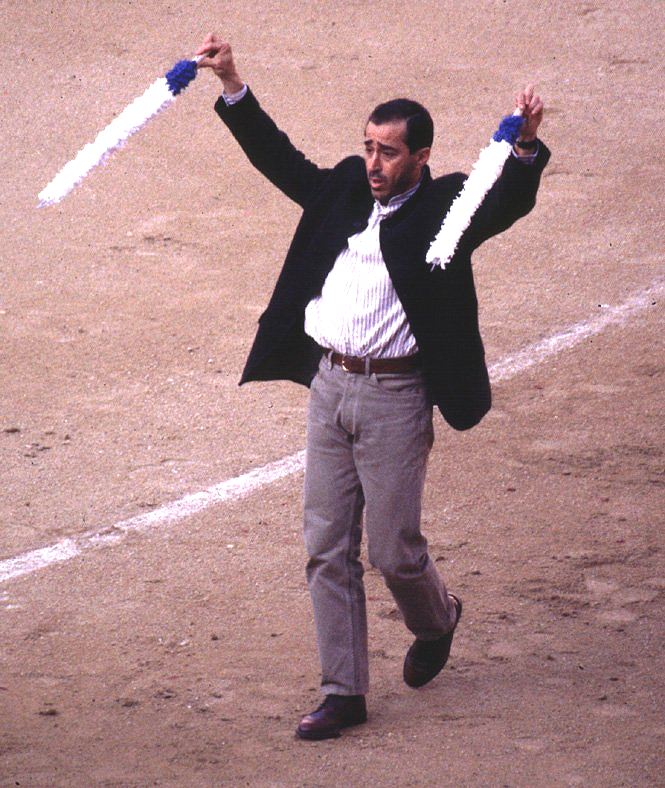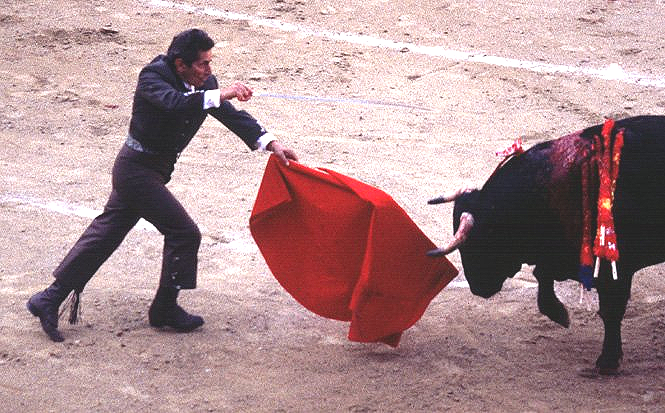A Las Ventas festival
El Soro (on crutches) at the centre of the paseíllo at the start of the festival for his benefit, Las Ventas, March 2 1997. The rejoneador is Conchita Cintrón, who made a token appearance in the paseíllo.
The announcement of Morante de la Puebla’s morning festival in Las Ventas on October 12, with the aim of raising funds for a statue of Antonio Chenel Antoñete, has reminded me of a festival I attended there in March 1997.
Curiously, this was a benefit for the Valencian matador Vicente Ruiz El Soro, who had never had a triumph in Las Ventas but whose career had seemingly been ended as a result of a progressively worsening injury to a knee that had first occurred during a corrida at Montoro (Córdoba) at the end of the 1993 temporada. The cartel for the festival - oldtimers Antoñete, Joselito Huerta, Andrés Vázquez, Sebastián Palomo Linares, Ruiz Miguel and Niño de la Capea along with the novillero Antonio Losada - was sufficiently attractive that I went to Spain for a long weekend that also took in the opening ‘three tenors’ corrida at Esquivias, where Enrique Ponce set the tone for the concept (up until José Tomás’s arrival) by out-performing Joselito and Francisco Rivera Ordóñez.
Antoñete citing from a distance and (below) in a natural
After a somewhat chaotic paseíllo, led by El Soro on crutches facing a mass of photographers, Antoñete (64) got things going. Looking somewhat unsteady on his legs, the veteran showed us two masterful media verónicas with his capote before embarking on his faena, which he began by citing the novillo from a distance. Fine series on each hand followed, with two majestic pases de pecho. There was a strong estocada al encuentro and Antoñete circled the ring with the novillo’s ear.
A caleserina from Joselito Huerta and (below) Luis Francisco Esplá, down from the tendidos, citing to place banderillas
The 63-year-old Mexican idol of the 1950s, Joselito Huerta, was up next. He had not appeared in Spain during my time as an aficionado, and I always welcomed the opportunity of exposure to Mexican toreo, so I was curious to see him. Dressed in an immaculate traje charro, he had his capote snatched from him initially but recovered for a couple of flowery Mexican lances and a quite of excellent gaoneras. Then Luis Francisco Esplá was enticed down from the tendidos for a superb tercio de banderillas! Huerta managed some good naturales in the faena, but had trouble killing, landing on his back after four pinchazos and an estocada, and being awarded a vuelta.
Andrés Vázquez entering to kill his novillo
Andrés Vázquez (64), on next, had even talked about a return to bullfighting prior to this festival! He had an unhappy afternoon, beginning with a lance on his knees, but losing the capote and unfairly pinning the blame on a peón. He ended his capework with a superb media verónica, but come the faena, with his novillo overpicced and cutting in and then taking up a querencia, he could achieve little with the muleta. He killed with a pinchazo and media estocada and was given an ovation. The return didn’t happen.
Sebastián Palomo Linares in a derechazo
Sebastián Palomo Linares was a favourite of mine from magazine reports in the 1960s, but I had only seen him torear once, in Salamanca in 1980. Grey-haired now, the former ‘guerrillero’ drew a spirited novillo, gave it some promising capework but a short faena that had some decent derechazos and chest passes but nothing on the left hand. Things ended with a poor sword.
Trincherilla from Francisco Ruiz Miguel
Next up was a fast-charging novillo for Francisco Ruiz Miguel. There was little to note with the capote, and the bull gave the banderilleros a hard time, but Paco was excellent in the faena, standing his ground and producing linked series of derechazos and naturales and even circulares. The matador was buffeted in an initial pinchazo, then produced a strong estocada, and was really pleased to be awarded the animal’s ear.
Niño de la Capea in a natural
The following performance by Pedro Moya Niño de la Capea was magical, the substantially-sized novillo seemingly totally in the spell of the salmantino’s muleta. There were lots of one-off detalles, but at the centre of the faena were wonderful series of derechazos and naturales. Pedro crowned his performance with a superb estocada recibiendo. He was awarded two ears, the crowd chanting, “Torero! Torero!”, and circled the ring with El Soro’s young son.
Antonio Losada
The festival ended with the novillero Antonio Losada, who failed to impress, managing some verónicas in between three varas and then producing a faena of unipases before prolonged swordwork led to an aviso and palmas.
Despite this low-key ending, the festival had been a wonderful experience for me, and I would advise any budding aficionado who is not familiar with the toreo of several of the participants of the October 12 festival - rejoneador Pablo Hermoso de Mendoza; the matadors Curro Vázquez, César Rincón, Enrique Ponce, Julio Aparicio and Morante de la Puebla; and the novillera Olga Casado - to make the effort to be there. Like my 1997 festival, it promises to be a memorable experience.









